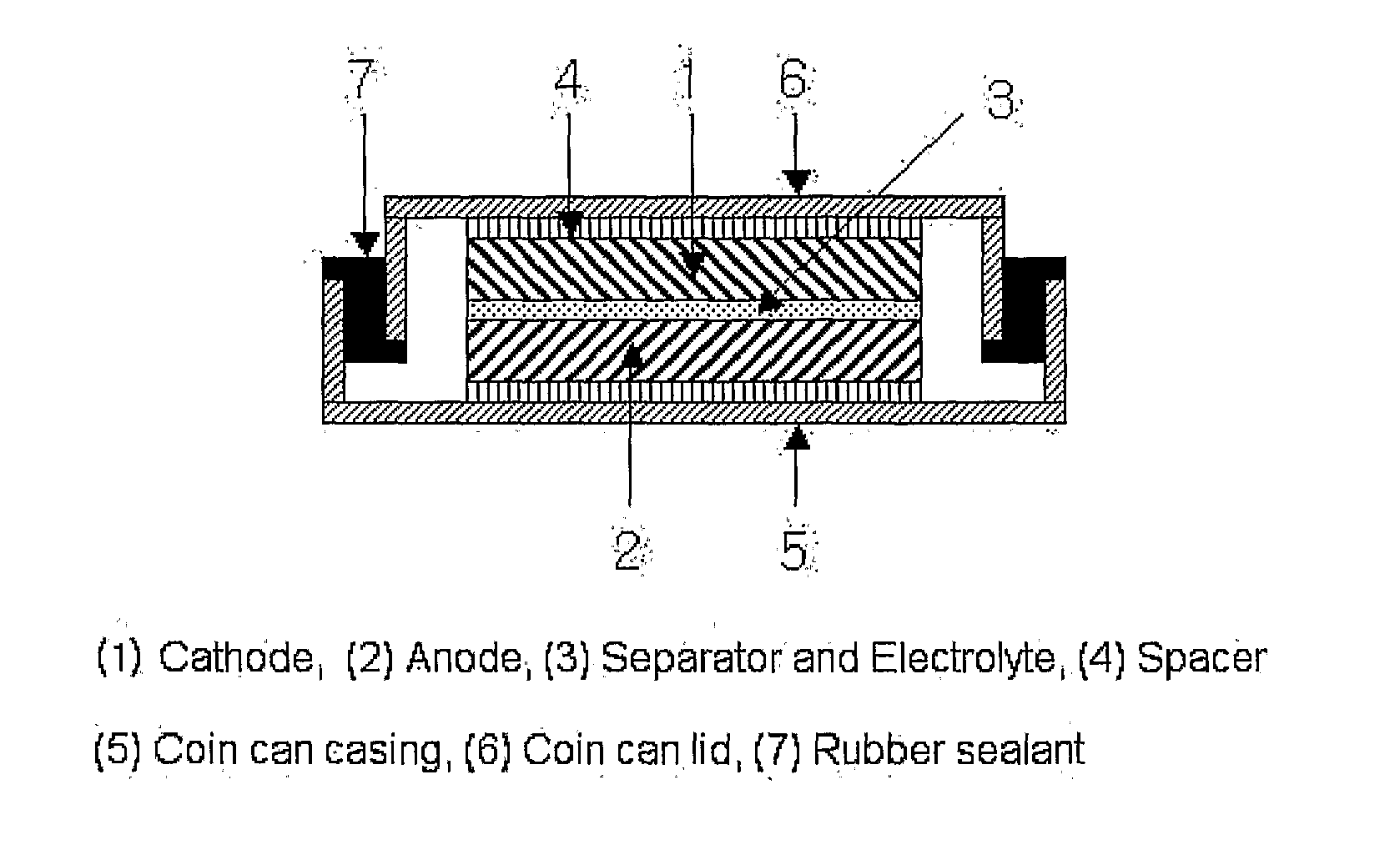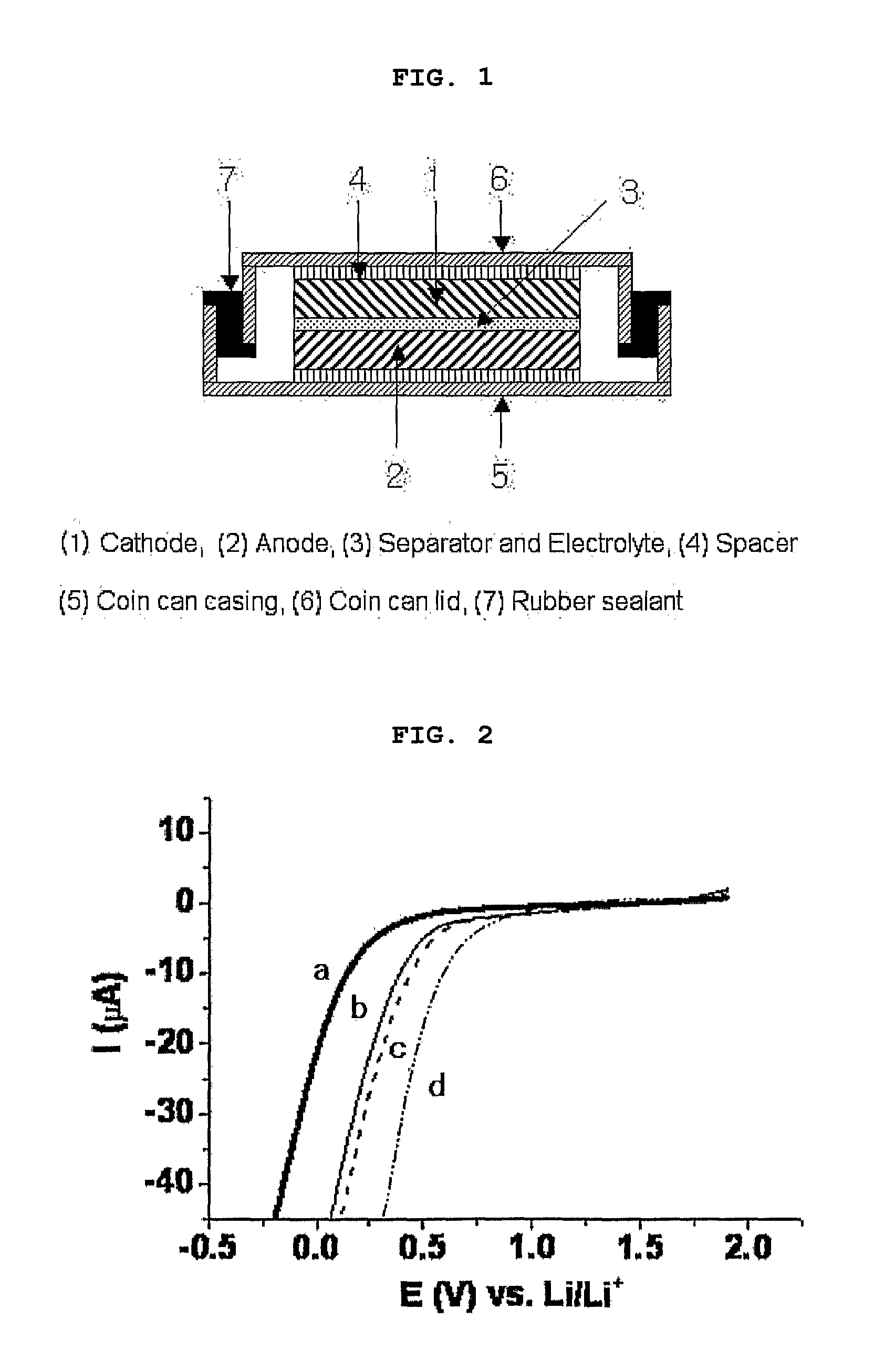Electrolyte comprising eutectic mixture and secondary battery using the same
a technology of eutectic mixture and electrolyte, which is applied in the field of electrolyte for a secondary battery, can solve the problems of inability to practically apply ionic liquid to a secondary battery, filtering, and high cost of ionic liquid production, so as to reduce the reduction potential of the amide group-containing compound, increase the electron density of the n—c bond, and reduce the electron density of the n—
- Summary
- Abstract
- Description
- Claims
- Application Information
AI Technical Summary
Benefits of technology
Problems solved by technology
Method used
Image
Examples
example 1
1-1. Preparation of Eutectic Mixture
[0077]An eutectic mixture (13 g) was obtained by mixing 7 g of ethyl N-methylcarbamate (CH3NHCOOC2H5) and 6 g of LiN(SO2CF3)2 in a molar ratio of 3:1 and then gradually stirring the resultant mixture at room temperature under a nitrogen atmosphere for 12 hours. Subsequently, moisture contained in the eutectic mixture was reduced to 20 ppm or less under a vacuum atmosphere of 0.3 torr.
1-2. Preparation of Secondary Battery
[0078]
[0079]LiCoO2 as a cathode active material, artificial graphite as a conductive material, and polyvinylidene fluoride as a binder were mixed in a weight ratio of 94:3:3, and N-methylpyrrolidone was added to the resultant mixture to thereby provide a slurry. The slurry was applied onto an aluminum foil, and then dried at 130° C. for 2 hours to thereby prepare a cathode.
[0080]
[0081]Graphite carbon as an anode active material, artificial graphite, and a binder were mixed in a weight ratio of 94:3:3, and N-methylpyrrolidone was ad...
experimental example 1
Evaluation of Reduction Potential of Eutectic Mixtures
[0087]An experiment was performed in which the reduction potentials of the eutectic mixtures obtained in Example 1-1 and Comparative Examples 1 to 3 were measured using cyclic voltammetry, and measurement results thereof were plotted in FIG. 2. In the experiment, glassy carbon was used as a working electrode, lithium metal was used as a reference electrode, and lithium metal is used as a counter electrode. Also, a scanning speed of 50 mV / s was used in the measurements.
[0088]As a result of the experiment, the eutectic mixture of Example 1-1 comprising N-methylcarbamate in which the ethyl group (EDG) was substituted at the N-position of the amide group exhibited a reduction potential of approximate 0.3V (see curve a in FIG. 2), and the eutectic mixtures of Comparative Examples 1 and 2, each comprising ethylcarbamate or methylcarbamate in which a substituent group was not introduced at the N-position of the amide group, exhibited a ...
experimental example 2
Performance Evaluation of Secondary Batteries
[0092]An experiment was performed in which each of the secondary batteries prepared in Example 1 and Comparative Examples 1 to 3 was charged / discharged at a rate of 0.5 C and its discharge capacity and charge / discharge efficiency according to a charge / discharge cycle were measured, and measurement results were plotted in FIGS. 3 to 6.
[0093]In Example 1-2 where the eutectic mixture comprising the amide group-containing compound with an EDG introduced into its N-position was used as an electrolyte component, the secondary battery exhibited a discharge capacity of 90% and a charge / discharge efficiency of 99.7% after 50 times of charge / discharge cycles (see FIG. 3).
[0094]Contrarily, in Comparative Examples 1 and 2, in each of which the eutectic mixture comprising the amide group-containing compound without any substituent group introduced into its N-position was used as an electrolyte component, the secondary battery of Comparative Example 1 ...
PUM
| Property | Measurement | Unit |
|---|---|---|
| charge/discharge voltage | aaaaa | aaaaa |
| temperature | aaaaa | aaaaa |
| temperature | aaaaa | aaaaa |
Abstract
Description
Claims
Application Information
 Login to View More
Login to View More - R&D
- Intellectual Property
- Life Sciences
- Materials
- Tech Scout
- Unparalleled Data Quality
- Higher Quality Content
- 60% Fewer Hallucinations
Browse by: Latest US Patents, China's latest patents, Technical Efficacy Thesaurus, Application Domain, Technology Topic, Popular Technical Reports.
© 2025 PatSnap. All rights reserved.Legal|Privacy policy|Modern Slavery Act Transparency Statement|Sitemap|About US| Contact US: help@patsnap.com



